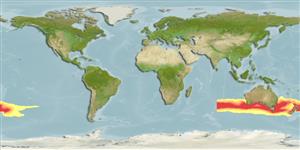Elasmobranchi (squali e razze) (sharks and rays) >
Carcharhiniformes (Ground sharks) >
Scyliorhinidae (Cat sharks) > Scyliorhininae
Etymology: Cephaloscyllium: cephalus, from kephale (Gr.), head, referring to its very broad and depressed head; skylion, Greek for dogfish or small shark. (See ETYFish); albipinnum: albus (L.), white; pinna (L.), fin, but used here as a neuter adjective (finned), referring to distinctive white margins on fins. (See ETYFish).
More on authors: Last, Motomura & White.
Environment: milieu / climate zone / depth range / distribution range
Ecologia
marino batipelagico; distribuzione batimetrica 126 - 554 m (Ref. 76947). Temperate
Distribuzione
Stati | Aree FAO | Ecosystems | Presenze | Point map | Introduzioni | Faunafri
Indo-West Pacific: Southern part of Australia.
Size / Peso / Age
Maturity: Lm ? range ? - ? cm
Max length : 101 cm TL maschio/sesso non determinato; (Ref. 76947); 102.5 cm TL (female)
Short description
Morfologia | Morfometria
A large species with the following characters: head 8.6-13.5% TL in height, trunk 16.1-23.8% TL in width; origin of first dorsal-fin usually forward of mid pelvic-fin base; prenarial 4.5-5.1% TL in length; length of preorbital snout 1.4-1.7 times prenarial length, 2.5-3.1 in prepectoral length, 6.3-6.9 in pre-pelvic length; snout-vent long, its length 48.1-52.4% TL; width of nostril 2.4-2.7% TL; eye-spiracle space wide, 1.0–1.4% TL; pectoral fin large, its height 12.6-13.6% TL, posterior margin 12.0-13.6% TL in length; anal fin tall, height 3.8–4.4% TL; anal-caudal space 4.0-5.6% SL; precaudal length 74-78% TL; interdorsal space 6.3-7.6% TL; teeth with 3-5 cusps near symphysis of upper jaw; mainly weak tricuspidate flank denticles; back without greatly enlarged denticles; long adult clasper, up to 8.8% TL, almost reaching anal fin, interspace about 4.4 in anal-fin base; vertebral centra 121-126; tooth count high, each jaw with 90-116 teeth; strong pattern of saddles and blotches on upper half of body; dark, transverse dorsal markings (9-10) on body and tail, interspaces between are narrow; interspiracular saddle subequal to eye and spiracle length; over and above gill slits with large circular blotch; fins with variably developed, narrow pale margins (Ref. 76947).
Life cycle and mating behavior
Maturità | Riproduzione | Deposizione | Uova | Fecundity | Larve
Last, P.R., H. Motomura and W.T. White, 2008. Cephaloscyllium albipinnum sp. Nov., a new swell shark (Carcharhihiformes: Scyliorhinidae) from Southeastern Australia. In Last, P.R., White, W.T. & Pogonoski, J.J. (eds.): Descriptions of New Australian Chondrichthyans. CSIRO Marine and Atmospheric Research Paper no. 22. (Ref. 76947)
IUCN Red List Status (Ref. 130435)
Threat to humans
Harmless
Human uses
Informazioni ulteriori
Nomi ComuniSinonimiMetabolismoPredatoriEcotossicologiaRiproduzioneMaturitàDeposizioneSpawning aggregationFecundityUovaEgg development
Age/SizeAccrescimentoLength-weightLength-lengthLength-frequenciesMorfometriaMorfologiaLarveDinamica popolazioni larvaliReclutamentoAbbondanzaBRUVS
BibliografiaAcquacolturaProfilo di acquacolturaVarietàGeneticaElectrophoresesEreditarietàMalattieElaborazioneNutrientsMass conversion
CollaboratoriImmaginiStamps, Coins Misc.SuoniCiguateraVelocitàModalità di nuotoArea branchialeOtolithsCervelliVista
Strumenti
Special reports
Download XML
Fonti Internet
Estimates based on models
Preferred temperature (Ref.
123201): 10.9 - 15.1, mean 12.6 °C (based on 44 cells).
Phylogenetic diversity index (Ref.
82804): PD
50 = 0.5000 [Uniqueness, from 0.5 = low to 2.0 = high].
Bayesian length-weight: a=0.00263 (0.00139 - 0.00497), b=3.21 (3.04 - 3.38), in cm total length, based on LWR estimates for this (Sub)family-body shape (Ref.
93245).
Trophic level (Ref.
69278): 4.2 ±0.5 se; based on size and trophs of closest relatives
Resilienza (Ref.
120179): Basso, tempo minimo di raddoppiamento della popolazione 4.5 - 14 anni (Preliminary K or Fecundity.).
Fishing Vulnerability (Ref.
59153): High vulnerability (62 of 100).
